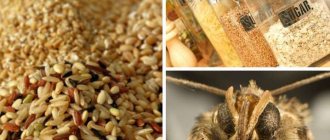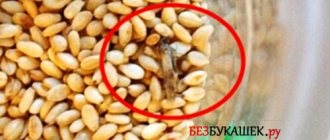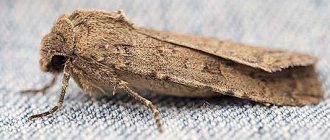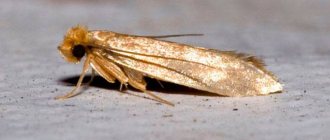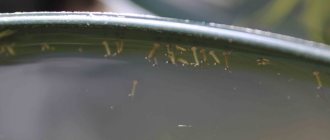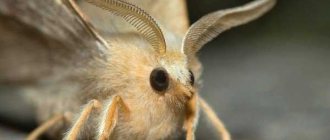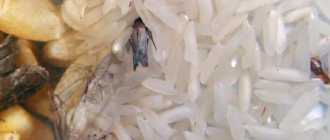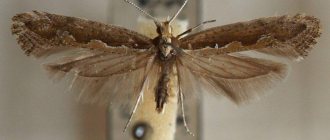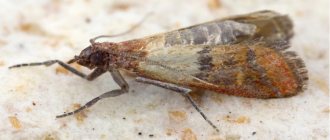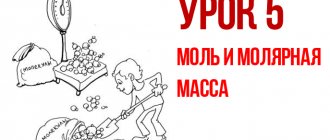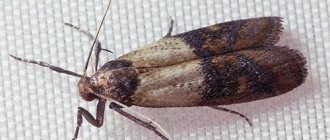Some types of moths have chosen human homes and gardens, turning into malicious pests. In nature, there are several hundred species of moths - inconspicuous butterflies that are mainly nocturnal. Some types of moths have taken a fancy to human homes and gardens, turning into malicious pests. They destroy things, especially furs and fabrics; settle in products, contaminating them and making them unsuitable for food. Where do moths come from, what species inhabit our homes and how do moths reproduce - the answers to these questions will help you cope with pests.
food moth
The food or fruit moth is an ugly gray butterfly with a wingspan of up to 9-10 mm. The moth looks inconspicuous in a static state due to the fact that it folds its wings in a special way - they are narrowly folded.
There are several types of food moths and they are all considered pests in the home.
There are several types of food moths and they are all considered pests in the home. They prefer to settle in houses, barns, granaries, vegetable stores, warehouses, and shops. It is in these places that food contamination by their larvae occurs. Flour moth prefers flour and cereals; fruit - dried fruits, mushrooms, spices, tea, herbs, nuts. Similarly, various types of moths can be found in cereals and dried fruits. To a person who is not an entomologist, all these species look the same - gray small butterflies with an unclear dark pattern on the wings.
Moths are nocturnal insects. During the day she hides in secret places and sleeps.
Brief description of the family
Moths are insects closely related to butterflies, although they are not actually butterflies, except as a general definition, to which the term "moth" also applies. Meanwhile, both moths and butterflies belong to the same order of Lepidoptera, and this is where their similarities end. There are more differences between butterflies and moths than just dry entomological taxonomy. To date, researchers have identified about 200 thousand species of butterflies around the world, and we can say for sure that there are at least five times more known representatives among moths.
All species are characterized by a general structure of the body and vital processes. The antennae of moths, as a rule, are shorter than those of butterflies, and along their length you can find shaggy “branching”, strongly reminiscent of frost on wires. When the insect sits, it folds its wings evenly, giving its body a narrow, flat shape. An exception may be several species that keep their wings unfolded at rest. The size of moths of different species can vary greatly - from a few millimeters to several centimeters.
These insects typically have thick, hairy bodies ranging in color from golden yellow to dark brown. Some species are characterized by a radical black color. The vast majority are active at night and rest during daylight hours in a preferably shady habitat.
Physiology
The adult moth lives up to 3 weeks. Some types of fruit moths live for several days, during which their task is to lay eggs. The moth goes through development stages: eggs - larval stage - pupa - adult insect. The moth reproduces quite quickly - food moths hatch up to 6 generations per year. Having laid eggs, the moth dies within a few hours. The insect itself does not eat as an adult, it only drinks. The moth lays eggs in foods, which are the food source for the larvae. Moth eggs are white.
The moth lays eggs in foods, which are the food source for the larvae.
The larva of the food pest looks like a light brown moth caterpillar, whose size can reach 2 cm. As soon as the larva is born, it begins to gnaw food. In this stage of development, the moth exists longer than in the adult stage - up to 60 days. This makes it clear why moths manage to cause so much damage to products and the economy as a whole. The larvae are inactive and remain in the environment in which they hatched from the eggs.
Natural "camouflage"
Nature gave such an inconspicuous color to moths for a reason. First of all, because the earthy shade is an excellent protection and allows you to avoid an unpleasant encounter with a hungry predator. An interesting fact is that representatives of different species of moths living in a particular environment acquire colors in accordance with its conditions. For example, the development of moths of forest species is more characterized by a greenish tint, while others are more characterized by the color of the bark of trees, which are more abundant in this area.
But science has become aware of an even more unique phenomenon, a property that only very few representatives of the insect world can boast of. It has been observed that in urban areas where there is heavy soot pollution, some species of moths actually become darker in color than insects of the same species living in less polluted areas.
Another effective form of camouflage is the shape that the insect takes on when at rest. Species that live primarily in tree crowns, as a rule, do not fold their wings at all in order to be more like dry leaves, while “grass” ones actually extend their wings into a line so that they cannot be distinguished from a blade of grass. Not least important is the flight strategy of the moth.
Few of these species fly straight and slowly. Many of us have observed house moths flying around in such a way that it becomes difficult to catch them. Light excites the insect, forcing it to be even more active, so the closer the light source, for example, a light bulb, the faster the moth will fly and the more chaotic at first glance its direction vector will be, which most often becomes circular.
An effective form of defense that other flying insects could take a few lessons from the moth is mimicry. Mimicry is the ability of a living organism to simulate the appearance of a larger or more threatening creature. This form of defense is used both by caterpillars with tails that look like the large head of a poisonous snake, and by adult individuals, whose war-spotted coloring on the outer surface of their unfolded wings scares off even large birds. Mimicry is also characteristic of some species of butterflies.
The scale of sabotage
Food moths destroy food supplies, infecting them with waste from their vital activity. Eating such foods is dangerous for humans. This may cause:
- allergic reactions;
- food poisoning;
- weakening of the immune system.
An allergic reaction is a consequence of food contamination with food moths
All products where moth larvae were found must be destroyed, which leads to large losses.
Signs of a pest
Moth larvae on clothes.
There are several visual signs that can help you identify pests in your home. The main one, of course, is the flying adult moths. But they are already an indicator of the spread of a large number of pests.
You can recognize the appearance of moths by small larvae in places where they can be very conveniently located: on the back walls of furniture, kitchen units, in unclosed bags of cereals and in cabinets with furniture. Small eggs are most often securely hidden, and they are almost colorless, so they cannot be identified.
Clothes moth
Another type of moth prefers to feed not on cereals and fruits, but on things - primarily fur, wool, fabric fibers, and less often - leather. This is the so-called clothes moth, which often appears at home in the summer. The moth feeds on any foods containing keratin protein. Accordingly, animal fabric (wool), fur, leather are suitable for this. If a moth damaged a fabric considered to be synthetic, it means that it contained up to 20% wool fibers.
Clothes moths feed on things - primarily fur, wool, fabric fibers, and less often - skin
Prevention measures
In order not to start a long and tedious struggle for your own things or products, it is better to take a number of preventive measures.
These include:
- proper storage of things and products. Clothes should be placed in the closet only after they have been cleaned and in special covers, if possible. Food products should be stored in sealed jars or bags;
- periodically clean the shelves and wash them. Linen needs to be shredded and supplies reviewed;
- for prevention . You can arrange bouquets of dried herbs and orange peels in the cabinets;
- It is good to inspect things after purchasing and purchase products only from trusted places.
All varieties of moths do not like the scent of lavender, mint, rosemary, citrus, geranium, camphor or cloves. You can buy a ready-made sachet, use a little essential oil, or even put some dried herbs in fabric bags.
Appearance and physiology
The clothes moth belongs to the species Tineola bisselliella. It looks like a small butterfly up to 16 mm in size. Butterfly wings can be dirty yellow or golden in color. Clothes moths move curiously - adult butterflies fly poorly or cannot fly at all, although they have wings, they run quite quickly across the surface of textiles.
Clothes moths prefer dry air, so they feel great at home, especially in winter when the central heating is on.
How to get rid of moth larvae
In order to effectively get rid of insects, you need to know their weaknesses. All varieties of moths will be afraid of bright light, strong odors, and large temperature changes (extreme cold or heat).
If colonies of insects have laid eggs in cereals and dry foods, then there is no point in saving them. Even after cooking or cooling inside the freezer, infection particles will remain in the mixtures.
The insect cannot tolerate large temperature changes
Cleaning sequence:
- Empty storage areas where butterflies or caterpillars have been spotted. Rinse all surfaces, including the joints between shelves, thoroughly adding a few drops of vinegar to the liquid.
- If there is a steam generator, then horizontal and vertical planes are treated with steam at a temperature of at least 70°C.
- As an alternative, you can use a hair dryer to dry your hair. If you set the hot air supply to maximum and direct it to the joints of the cabinet parts, this will eliminate the laid eggs.
- All products that have had contact with air should be packed in plastic bags and thrown out of the house.
- Storage containers must be washed in the dishwasher or disinfected in the freezer. Accommodation for 24 hours will be sufficient.
If voracious insects are infested in the dressing room, then you should not part with your clothes. General cleaning and disinfection are required.
gor_san_mos
gor_san_mos
gor_san_mos
Algorithm of actions:
- First of all, it is worth treating all the internal walls of the storage facility. This can be wet cleaning with vinegar, which is carried out similarly to the rules for cleaning kitchen cabinets. Next, taking into account the material used to make the shelves and partitions, a steam generator or hot air from a hair dryer is used.
- It is better to wash or iron things, linen and materials with which moths have come into contact with a steam iron with a high temperature spray of boiling water.
- You can resort to dry cleaning services. This option will be a salvation for delicate or fur items.
The problem with furniture insects is considered the most difficult, since large items or heavy carpet cannot be washed in a household washing machine.
Sofas, armchairs, beds and carpets can be cleaned:
- a washing vacuum cleaner with added chemicals;
- steam generator at maximum temperature;
- by calling furniture dry cleaning specialists.
All options that help get rid of moths can be divided into traditional and modern.
Traditional methods
Knowing at what temperature moth larvae die (heating above 43°C or freezing below 17°C), you can disinfect furniture or things in contrasting modes.
For example, it is recommended to take sofas and carpets outside in winter during severe frosts for a day. This will be enough to destroy the shell of the eggs. Small clothes and linens can be placed in the home freezer for 12 hours. After defrosting, simply wash and iron the items with a steam iron.
However, such radical methods will only withstand dense fabrics and upholstery.
A more delicate method to get rid of insects is persistent natural flavors:
- fresh and dried spicy herbs lavender, mint, wormwood, tansy, yarrow;
- orange peels;
- home flowers geranium and carnation;
- aroma oils;
- tobacco.
Chemicals
Modern developers of household chemicals can offer quick relief from pests:
- sprays for treating clothing and furniture;
- ready-made sachets with herbs that have a pungent odor;
- stickers for food moths;
- clothes moth tablets;
- automatic devices for repelling insects.
galinakorvai
pettown.ru
favorite_shop13
When using such products, you need to make sure that family members do not have allergic reactions to their composition.
Types of moths and their ways of entering the home (video)
Each moth lays up to 200 eggs. They are oval in shape, up to 0.6 mm in size. Moth caterpillars reach a length of a centimeter. They are yellowish in color, but are capable of changing their skin several times during their life. At this stage of development, the larvae can live from 70 to 200 days. The cooler the house, the longer the larval stage. In unfavorable conditions and in the absence of food, the larva can exist for up to 2 years. The clothes moth produces only one generation per year, which is determined by the feeding conditions of its larvae and the duration of their development.
How they develop and reproduce
The development cycle is standard for this class of insects. Adults lay white or silvery microscopic eggs, from which small caterpillars emerge.
This phase of the moth's life is the most dangerous for fabrics and dry foods. During the growth process, the larva requires the maximum amount of food, and the structure of the insect's jaws allows it to process a large amount of material.
Breeding cycle
After the moths appear, their main function will only be reproduction.
Males die immediately after mating. Females end their lives after laying eggs, the number of which can reach several hundred.
Damage caused
Clothes moth caterpillars eat holes in fabrics and turn fur into dust, destroying its fibers to the core.
You can also learn about methods and means of fighting moths in the closet by reading the corresponding article on our website.
To protect your home from clothes moths, you need to carefully check all things brought into the house.
Types of house pests
The definition of “domestic” refers to all types of moths living in an apartment or house. There are several main types of house moths:
- food (lives mainly in the kitchen, eats cereals, cereals, nuts, dried fruits);
- clothes (lives in closets with clothes, feeds on fabrics);
- fur coat (eats fur);
- furniture (settles on upholstered furniture, feeds on its upholstery);
- carpet (lays eggs and develops in the pile of various carpets).
The differences between species are not only in what the moth looks like, but also in where it lives and what it eats. Thus, clothes moth larvae will never end up in a package of cereal, and food moths will not spoil a fur coat or woolen sweater.
Ways to get into the house
Where do clothes moths come from in the house? It enters the house in approximately the same ways as food:
- through open windows and doors;
- together with old things affected by moths;
- through the ventilation holes.
To protect your home from clothes moths, you need to carefully check all things brought into the house. Special attention should be paid to various antique items that have old textiles, leather or fur. Moth larvae can live here, which, under favorable conditions at home, will reach the adult stage and begin to reproduce.
Features of vision
Moths, like many other species of adult insects, have compound and simple eyes. Complex ones consist of many hexagonal lenses, or corneas, that focus light from each part of the visual field onto a special surface - the equivalent of our retina. The optic nerve carries visual information to the brain of insects.
Such features allow these nocturnal representatives of the animal world to perfectly navigate in pitch darkness, and also to see only those objects that may be interesting and useful to them, everything else is actually eliminated as unnecessary. Among other things, moths are able to see ultraviolet rays, which are completely invisible to the human eye.
It is worth noting that visual qualities vary in moths depending on the different stages of development of the life cycle. Who said that the caterpillar has no eyes? Many species have them, including the larvae of the same clothes moth, and they perfectly help it navigate in the environment. However, caterpillars only have simple eyes, or, as scientists call them, ocelli, which can only distinguish darkness from light. But such eyes are not capable of forming an image; meanwhile, nothing prevents the moth larva from “seeing” the light entering through the open cabinet door and quickly retreating deeper into its nest.
Physically, the eyes of moth larvae consist of photoreceptors (light-sensitive cells) and pigments, which, when exposed to light, change their chemical structure, becoming irritating to the nerve receptors of the optic nerves, forcing the larva to hide away. But the caterpillars themselves have three times more eyes than humans, which are located in the form of a semicircular ring on each side of the head, providing almost 360-degree visibility.
Methods for killing moths (video)
No matter where the moth appears in the house and no matter what genus it belongs to, at the sight of nondescript, chaotically flying butterflies, you should get excited and take all measures to destroy them. This will save food and things from spoilage and save a lot of money. Today there are many ways to combat moths, allowing you to get rid of them efficiently and in the shortest possible time.
What do moths eat in an apartment?
It is a rather “picky” insect in its diet: it prefers natural fabrics, especially wool , so fur coats are often the object of attack. However, there are cases when this butterfly ate unnatural, synthetic fabrics . This is due to a lack of optimal nutrition.
Does the insect eat cotton? She loves it very much, so if your T-shirt or trousers are entirely made of this material, the parasite attacks them first. Therefore, even if you do not have these insects at home, treat the fabric before putting your clothes in the closet . This will protect you from unpleasant finds next season or during a wardrobe revision.
As for drinking, moths drink exclusively water , unlike cockroaches, who prefer alcoholic drinks and mash. Therefore, the opinion that the parasite appears due to the presence of stagnant water in or near the house is erroneous.
Traditional methods
Traditional methods, although quite effective, do not work very quickly. They are best used as preventive measures. These include various herbs that repel adults with their aroma. They do not affect the larvae. Mothballs were often used for things. It is effective, but things acquire an unpleasant aroma.
Bags with lavender for moths.
There is one proven folk method - shaking it up. The insect does not like disturbances and changes in climate conditions. Therefore, at the first suspicion of infection, you need to shake up all deposits of rags. Natural furs and coats should be carefully inspected and checked for damage. In summer you will need to put it in the sun, and in winter in the cold.
Interesting Facts
Now you know how long an adult lives. But there are still points to consider.
- We can say for sure that moths do not bite. Caterpillars are not capable of this. Yes, they don’t need this, since there is nothing interesting or nutritious for the parasite in human skin. The myth about the moth bite was born in apartments where mosquitoes hide in the corners and butterflies are in plain sight. At night, mosquitoes bite, and a person thinks that the butterfly is to blame. A moth can land on a light bulb, but nothing more.
- There are moth caterpillars that eat the keratin found in the horns of African antelopes. Some species prefer wax from bee hives.
- Almost all types of moths are similar. They have a brown head and a light body with a pinkish or yellowish tint. The larvae in appearance resemble codling moths from apple trees.
- All types of moths are pests. Insects cause damage to food, clothing, mushrooms, bushes, and trees. Butterflies do not pose a threat to humans.
- Moths do not eat synthetic things. The larva is able to eat things with synthetics, but only if they contain natural fibers. The growth of the pest is slow.
- A number of moth species retain their gnawing apparatus. Butterflies are not capable of damaging clothing. They simply have not lost an unnecessary nutritional organ.
Life cycle
How long does a pest live? Development comes with complete transformation. The insect lays eggs (60-230 pieces). After 13 days at a temperature of 20 degrees, they produce caterpillars. The latter are engaged in the construction of cocoons from the nutritious material on which they live. How long does a moth spend in the butterfly state? The stage lasts approximately 7 months. The insect spends up to 44 days as a pupa.
Fledged individuals can live up to 4 weeks. Over the course of a year, pests produce 2 generations if they are in a room at room temperature.
In the process of evolution, the house moth has lost its oral apparatus as unnecessary
